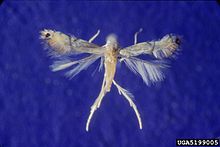- Phyllocnistis citrella
-
Phyllocnistis citrella 

Scientific classification Kingdom: Animalia Phylum: Arthropoda Class: Insecta Order: Lepidoptera Family: Gracillariidae Genus: Phyllocnistis Species: P. citrella Binomial name Phyllocnistis citrella
Stainton, 1856The Citrus leafminer (Phyllocnistis citrella) is a moth of the Gracillariidae family. It was first found in Florida in 1993,[1] but is now found all over the world, including Argentina, Australia, Brazil, China, Corsica, Costa Rica, Cuba, India, Israel, Malaysia, Mauritius, South Africa, Mexico, the Philippines, Spain, and other parts of the United States.
The wingspan is about 5 mm.
The larvae are considered a serious agricultural pest on Citrus species, such as Aegle marmelos, Atalantia, Citrofortunella microcarpa, Citrus limon, Citrus paradisi, Citrus maxima, Fortunella margarita, Murraya paniculata and Poncirus trifoliate. Larvae have also been recorded on Garcinia mangostana, Pongamia pinnata, Alseodaphne semecarpifolia, Loranthus and Jasminum sambac. They mine the leaves of their host plant. The mine consists of a long epidermal corridor with a well-marked central frass line. The mine is mostly lower-surface, but sometimes upper-surface, and rarely on the rind of the developing fruit. Citrus leaf miner larvae are thus protected from many topic insecticide treatments. Pupation takes place in a chamber at the end of the corridor, under an overturned part of the leaf margin.
The adult citrus leafminers mating communication is mediated by sex pheromones emitted by the adult females. A new lure that is environmentally friendly, species specific and emits the naturally occurring citrus leafminer pheromone has been developed targeting the management of this pest [2]. The lure attracts adult male citrus leafminers to an insect pheromone trap over a period of 4 to 8 weeks, allowing users to monitor for its presence, and to determine the relative population density in the field, or use it to actually control populations by mass trapping the males. The pheromone can also be used in the field without a trap to control the pest. Recently the formulation SPLAT CLM [3] , which combines nature-identical pheromone with SPLAT, has been registered with the US EPA to control the citrus leafminer using the environmentally friendly mating disruption strategy. Unlike wide spectrum insecticides which may impact beneficial insects (such as bees) or may cause insecticide resistance build-up, these pheromone based strategies not cause resistance, and avoid pollution.
Gallery
External links
- Center for Invasive Species - Citrus Leafminer
- citrus leafmioner on the UF / IFAS Featured Creatures Web site
- [1] Pheromone for mating disruption of Citrus Leaf Miners
- [2] Pheromone Traps for the monitoring and mass trapping of Citrus Leaf Miners
Notes
- ^ http://cisr.ucr.edu/citrus_leafminer.html - Center for Invasive Species
- ^ http://www.iscatech.com/exec/DocLib/ISCA_Product_Brochure_-_CLM.pdf
- ^ http://www.iscatech.com/ecommerce/index.php?main_page=product_info&products_id=134
This article relating to moths in genus Phyllocnistis is a stub. You can help Wikipedia by expanding it.






